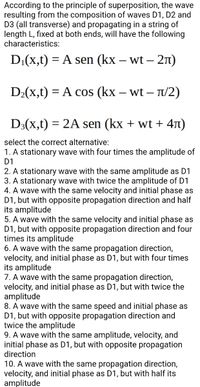
College Physics
11th Edition
ISBN: 9781305952300
Author: Raymond A. Serway, Chris Vuille
Publisher: Cengage Learning
expand_more
expand_more
format_list_bulleted
Concept explainers
Question

Transcribed Image Text:According to the principle of superposition, the wave
resulting from the composition of waves D1, D2 and
D3 (all transverse) and propagating in a string of
length L, fixed at both ends, will have the following
characteristics:
D:(x,t) = A sen (kx – wt – 2n)
|
D2(x,t) = A cos (kx – wt – T/2)
D3(X,t) = 2A sen (kx + wt + 4T)
select the correct alternative:
1. A stationary wave with four times the amplitude of
D1
2. A stationary wave with the same amplitude as D1
3. A stationary wave with twice the amplitude of D1
4. A wave with the same velocity and initial phase as
D1, but with opposite propagation direction and half
its amplitude
5. A wave with the same velocity and initial phase as
D1, but with opposite propagation direction and four
times its amplitude
6. A wave with the same propagation direction,
velocity, and initial phase as D1, but with four times
its amplitude
7. A wave with the same propagation direction,
velocity, and initial phase as D1, but with twice the
amplitude
8. A wave with the same speed and initial phase as
D1, but with opposite propagation direction and
twice the amplitude
9. A wave with the same amplitude, velocity, and
initial phase as D1, but with opposite propagation
direction
10. A wave with the same propagation direction,
velocity, and initial phase as D1, but with half its
amplitude
Expert Solution
This question has been solved!
Explore an expertly crafted, step-by-step solution for a thorough understanding of key concepts.
This is a popular solution
Trending nowThis is a popular solution!
Step by stepSolved in 2 steps

Knowledge Booster
Learn more about
Need a deep-dive on the concept behind this application? Look no further. Learn more about this topic, physics and related others by exploring similar questions and additional content below.Similar questions
- i need the answer quicklyarrow_forwarda° y(z,t) 1 d*y(x,t) Which of the following wave functions satisfies the wave equation? A.) y(x, t) = A cos(kæ + wt) B.) y(x, t) = A sin(kx +wt) C.) y(x, t) = A[cos(kæ) + cos(wt)] For any of the equations above that satisfy the wave equation what are the transverse velocity and acceleration of a particle at point x?arrow_forwardA standing wave has the following wave-function: y(x,t) = 0.2 sin(TIX) cos(12Ttt), where x and y are in meters, and t is in seconds. If the length of the string is L = 2 m and it is fixed at both ends, then the harmonic, n, in which the string is vibrating is: O n= 3 O n= 6 O n = 5 n = 2 n = 4 A standing wave with wavelength A = 1.2 m and frequency f = 50 Hz is generated on a stretched cord. For an element of the cord at x = 0.5 m, the maximum transverse velocity is v(y,max) = 2t m/s. The amplitude A of each of the individual waves producina the standing wave is:arrow_forward
arrow_back_ios
arrow_forward_ios
Recommended textbooks for you
 College PhysicsPhysicsISBN:9781305952300Author:Raymond A. Serway, Chris VuillePublisher:Cengage Learning
College PhysicsPhysicsISBN:9781305952300Author:Raymond A. Serway, Chris VuillePublisher:Cengage Learning University Physics (14th Edition)PhysicsISBN:9780133969290Author:Hugh D. Young, Roger A. FreedmanPublisher:PEARSON
University Physics (14th Edition)PhysicsISBN:9780133969290Author:Hugh D. Young, Roger A. FreedmanPublisher:PEARSON Introduction To Quantum MechanicsPhysicsISBN:9781107189638Author:Griffiths, David J., Schroeter, Darrell F.Publisher:Cambridge University Press
Introduction To Quantum MechanicsPhysicsISBN:9781107189638Author:Griffiths, David J., Schroeter, Darrell F.Publisher:Cambridge University Press Physics for Scientists and EngineersPhysicsISBN:9781337553278Author:Raymond A. Serway, John W. JewettPublisher:Cengage Learning
Physics for Scientists and EngineersPhysicsISBN:9781337553278Author:Raymond A. Serway, John W. JewettPublisher:Cengage Learning Lecture- Tutorials for Introductory AstronomyPhysicsISBN:9780321820464Author:Edward E. Prather, Tim P. Slater, Jeff P. Adams, Gina BrissendenPublisher:Addison-Wesley
Lecture- Tutorials for Introductory AstronomyPhysicsISBN:9780321820464Author:Edward E. Prather, Tim P. Slater, Jeff P. Adams, Gina BrissendenPublisher:Addison-Wesley College Physics: A Strategic Approach (4th Editio...PhysicsISBN:9780134609034Author:Randall D. Knight (Professor Emeritus), Brian Jones, Stuart FieldPublisher:PEARSON
College Physics: A Strategic Approach (4th Editio...PhysicsISBN:9780134609034Author:Randall D. Knight (Professor Emeritus), Brian Jones, Stuart FieldPublisher:PEARSON

College Physics
Physics
ISBN:9781305952300
Author:Raymond A. Serway, Chris Vuille
Publisher:Cengage Learning

University Physics (14th Edition)
Physics
ISBN:9780133969290
Author:Hugh D. Young, Roger A. Freedman
Publisher:PEARSON

Introduction To Quantum Mechanics
Physics
ISBN:9781107189638
Author:Griffiths, David J., Schroeter, Darrell F.
Publisher:Cambridge University Press

Physics for Scientists and Engineers
Physics
ISBN:9781337553278
Author:Raymond A. Serway, John W. Jewett
Publisher:Cengage Learning

Lecture- Tutorials for Introductory Astronomy
Physics
ISBN:9780321820464
Author:Edward E. Prather, Tim P. Slater, Jeff P. Adams, Gina Brissenden
Publisher:Addison-Wesley

College Physics: A Strategic Approach (4th Editio...
Physics
ISBN:9780134609034
Author:Randall D. Knight (Professor Emeritus), Brian Jones, Stuart Field
Publisher:PEARSON